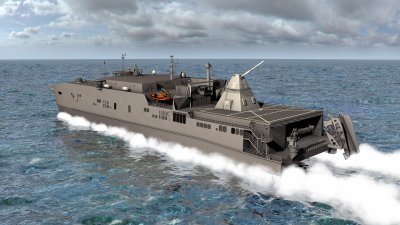
An artist rendering illustrates the Office of Naval Research-funded electromagnetic railgun installed aboard the joint high-speed vessel USNS Millinocket (JHSV 3). Deputy Secretary of Defense Bob Work observed the live fire of three guns, including the electromagnetic railgun - a long-range weapon that launches projectiles using electricity instead of chemical propellants - at the Naval Surface Warfare Center Dahlgren Division (NSWCDD) Potomac River Test Range April 30, 2015. He witnessed the first time an HVP was fired from the MK 45 Mod 4 gun system and observed a shot in the commissioning series of the new repetitive-rate medium caliber electromagnetic railgun, sponsored by the Office of Naval Research. "We continue to improve current capabilities while we also identify new technologies and ways of fighting to bolster our operational advantages," said Work. "Though there is much prototyping and demonstrating left to do, the implications for the future are game-changing." (U.S. Navy photo illustration/Released)
DAHLGREN, Va.—It was more than déjà vu for the Marine as he loaded a hypervelocity projectile (HVP) into a gun at the Potomac River Test Range April 30.
The former artillery battery and battalion commander saw first-hand how the Department of Defense (DoD) is developing game-changing technology.
Minutes later, he heard the 5-inch, 62-caliber open mount gun boom as it fired the advanced projectile over the test range.
It was a typical day at the range with one grand exception.
The Marine loading the HVP was none other than Deputy Secretary of Defense Bob Work.
Work visited the Naval Surface Warfare Center Dahlgren Division (NSWCDD) to thank service members and civilians, and to observe the live fire of three guns: the 5-inch, 62-caliber open mount test gun; the MK 45 Mod 4 gun system; and the electromagnetic railgun.
Work highlighted the Defense Innovation Initiative, a DoD-wide effort to sustain and advance America's military dominance for the 21st century.
Moreover, he emphasized the importance of investing in innovation, reforming the defense enterprise, and maintaining U.S. technological superiority.
"We continue to improve current capabilities while we also identify new technologies and ways of fighting to bolster our operational advantages," said Work. "Though there is much prototyping and demonstrating left to do, the implications for the future are game-changing."
During his visit, Work witnessed the first time an HVP was fired from the MK 45 Mod 4 gun system.
"It was an honor to demonstrate the HVP's launch compatibility with this gun system for the Deputy Secretary of Defense," said NSWCDD Commander Capt. Brian Durant. "This is the first step toward integrating the hypervelocity projectile into the Navy's MK 45 Mod 4 gun system."
The MK 45 Mod 4 gun system - the current gun system deployed on the Navy's newest ships - enhances Naval Surface Fire Support capabilities and provides fire mission flexibility for anti-surface and anti-air warfare.
The HVP - combined with the MK 45 - will support various mission areas including naval surface fire support, and has the capacity to expand to a variety of anti-air threats, anti-surface, and could expand the Navy's engagement options against current and emerging threats.
At the electromagnetic railgun facility, the deputy secretary of defense witnessed a shot in the commissioning series of the new repetitive-rate medium caliber electromagnetic railgun, sponsored by the Office of Naval Research.
"This gun will serve as a laboratory research device for experiments on repetitive-rate bore life, instrumentation, and controls development," said NSWCDD Technical Director Dennis McLaughlin who, along with Durant, accompanied Work throughout his visit. "We use smaller caliber railguns for risk reduction before testing concepts in major caliber. This science and technology effort is targeting repetitive-rate launcher and pulse-power risk reduction to ensure successful railgun weapon system demonstrations."
Electromagnetic railgun technology uses an electromagnetic force - known as the Lorenz Force - to rapidly accelerate and launch a projectile between two conductive rails. The guided projectile is launched at such high velocities that it can achieve greater ranges than conventional guns. It harnesses enough kinetic energy that it doesn't require any kind of high explosive payload when it reaches its target.
High-energy electromagnetic railguns are expected to be lethal and effective against multiple threats, including enemy warships, small boats, air targets and land-based targets.
"The deputy secretary of defense saw capabilities that are crucial in sustaining our warfighting edge and technological superiority," said Durant. "Hypervelocity projectiles fired from powder guns and the electromagnetic railgun are important technologies in the Navy's mixed arsenal of current and future weapons."
The electromagnetic railgun technology will complement current kinetic weapons currently aboard surface combatants and offer a few specific advantages.
It represents an "incredible new offensive capability for the U.S. Navy," said Navy Chief Engineer Rear Adm. Bryant Fuller in an April 2014 news release about plans to install and test a prototype electromagnetic railgun aboard a joint high speed vessel in fiscal year 2016. "This capability will allow us to effectively counter a wide-range of threats at a relatively low cost, while keeping our ships and Sailors safer."
The cost per engagement against specific threats is orders of magnitude less expensive than comparable missile engagements. The railgun projectile is being designed to enable the conservation of expensive missiles for use against more complex threats.
"NSWCDD will leverage its knowledge of electromagnetic launchers, hypervelocity projectiles, and directed energy weapons, as well as its established core capabilities in complex warfare systems development and integration," to incorporate electric weapons technology into existing and future fighting forces and platforms, stated McLaughlin and Durant in NSWCDD's 2015-2020 Strategic Plan.
NSWCDD, a NAVSEA warfare center division, is a premier research and development center that serves as a specialty site for weapon system integration. The command's unique ability to rapidly introduce new technology into complex warfighting systems is based on its longstanding competencies in science and technology, research and development, and test and evaluation.


